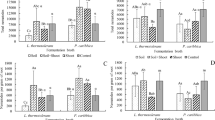Abstract
Root-knot disease caused by Meloidogyne incognita is a matter of grave concern because it affects several economically important crop plants. The use of solid-state fermentation (SSF) may help to elaborate efficient formulations with fungi to be employed in the biologic control of nematodes. Attempts were made to select low-cost substrates for spore production of a strain of Paecilomyces lilacinus with known nematicide capacity. Coffee husks, cassava bagasse, and defatted soybean cake were utilized as substrates, and sugarcane bagasse was used as support. Fermentations were carried out in flasks covered with filter paper at 28°C for 10 d. The products obtained by SSF were evaluated for their nematicide activity in pot experiments containing one seedling of the plant Coleus inoculated with the nematode M. incognita. The plants were evaluated 2 mo after inoculation. Fermented products showed a reduction in the number of nematodes. The best results were obtained with defatted soybean cake, which showed almost 100% reduction in the number of nematodes; the reduction with coffee husk was 80% and with cassava bagasse was about 60%.
Similar content being viewed by others
References
Jatala, P. (1986), Annu. Rev. Phytopathol. 24, 453–489.
Mankau, R. (1980), J. Nematol. 12, 244–252.
Siddiqui, Z. A. and Mahmood, I. (1999), Bioresour. Technol. 69, 167–179.
Morgan-Jones, G., White, J. E., and Rodriguez-Kabana, R. (1984), Nematropica 14, 57–71.
Rodriguez-Kabana, R., Morgan-Jones, G., and Chet, I. (1987), Plant Soil 100, 237–247.
Cabanillas, E., Barker, K. R., and Nelson, L. A. (1989), J. Nematol. 21, 164–172.
Mittal, N., Saxena, G., and Mukerji, K. G. (1995), Crop Protection 8, 647–651.
Hewlett, T. E., Dickson, D. J., Mitchell, D. J., and Kannwischer-Mitchell, M. E. (1988), J. Nematol. 20, 578–584.
Dube, B. and Smart, G. C., Jr. (1987), J. Nematol. 19, 222–227.
Godoy, G., Rodriguez-Kábana, R., and Morgan-Jones, G. (1983), Nematropica 13, 111–119.
Pandey, A., Soccol, C. R., Nigam, P., and Soccol, V. T. (2000), Bioresour. Technol. 74, 69–80.
Pandey, A., Soccol, C. R., Nigam, P., Soccol, V. T., Vandenberghe, L. P. S., and Mohan, R. (2000), Bioresour. Technol. 74, 81–87.
Soccol, C. R. and Pandey, A. (2003), in Concise Encyclopedia of Bioresource Technology, Haworth, New York, pp. 411–423.
Roussos, S., Bagnis, C., Besnard, C., Sigoillot, C., Duponnois, R., and Augur, C. (2000), in Coffee Biotechnology and Quality, vol. 1, Sera, T., Soccol, C. R., Pandey, A., and Roussos, S., eds., Kluwer Academic, Dordrecht, The Netherlands, pp. 277–286.
Fan, L., Pandey, A., and Soccol, C. R. (2000), J. Basic Microbiol. 40, 177–187.
Fan, L., Pandey, A., and Soccol, C. R. (2000), Acta Biotechnol. 20, 41–52.
Machado, C. M. M., Oliveira, B. H., Pandey, A., and Soccol, C. R. (2000), in Coffee Biotechnology and Quality, vol. 1, Sera, T., Soccol, C. R., Pandey, A., and Roussos, S., eds., Kluwer Academic, Dordrecht, The Netherlands, pp. 401–408.
Soccol, C. R. and Vandenberghe, L. P. S. (2003), Biochem. Eng. J. 13, 205–218.
Soccol, C. R. (1996), J. Sci. Ind. Res. 55, 358–364.
Medeiros, A., Pandey, A., Christen, P., Fontoura, P. S. G., Freitas, R. J. S., and Soccol, C. R. (2001), World J. Microbiol. Biotechnol. 17, 767–771.
Vandenberghe, L. P. S., Soccol, C. R., Pandey, A., and Lebeault, J. M. (2000), Bioresour. Technol. 74, 175–178.
Germano, S., Pandey, A., Osaku, C. A., Rocha, S., and Soccol, C. R. (2003), Enzyme Microb. Technol. 32, 246–251.
Pandey, A., Soccol, C. R., Nigam, P., and Soccol, V. T. (2000), Bioresour. Technol. 74, 69–80.
Leger, S. R., Joshi, L., and Roberts, D. W. (1997), Microbiology 143, 1983–1992.
Roussos, S., Raimbault M., Saucedo-Castañeda, G., Viniegra-González, G., and Lonsane, B. K. (1991), Micol. Neotrop. Appl. 4, 19–40.
Alam, M. M. (1989), Indian J. Nematol. 19, 166–170.
Kerry, B. R. (1994), Helminthol. Abstr. Ser. B 53, 1–14.
Author information
Authors and Affiliations
Corresponding author
Rights and permissions
About this article
Cite this article
Brand, D., Roussos, S., Pandey, A. et al. Development of a bionematicide with Paecilomyces lilacinus to control Meloidogyne incognita . Appl Biochem Biotechnol 118, 81–88 (2004). https://doi.org/10.1385/ABAB:118:1-3:081
Received:
Revised:
Accepted:
Issue Date:
DOI: https://doi.org/10.1385/ABAB:118:1-3:081




